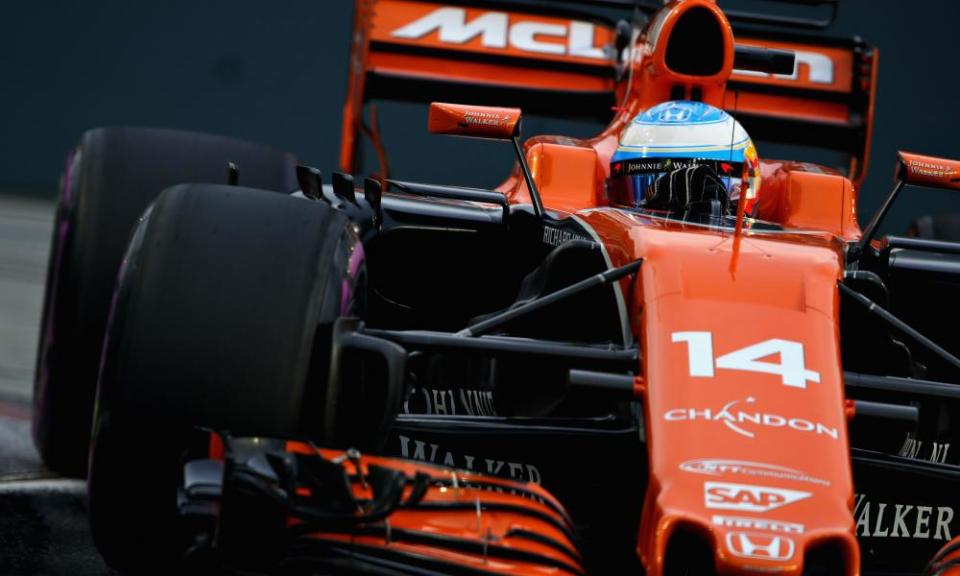McLaren’s F1 engine switch gives power to team’s belief they can revive fortunes | Giles Richards

A return to “normality” in Formula One next season – “to be on the podium and fight for victories” – is Fernando Alonso’s expectation for McLaren after the team formally announced their partnership with Honda would end this year. The relationship has proved to be a very public car crash for the team and the engine manufacturer over the last three years and Alonso has been absolutely clear that he held Honda responsible. His optimism stems from the switch to Renault power units but the task that lies ahead for McLaren remains immense.
The most successful British racing team, with eight constructors’ and 12 driver’s titles, have not won a race since Jenson Button’s victory at Brazil in 2012. They have not claimed a constructors’ title since 1998. The switch to Renault is not going to reverse this trend overnight but it may be enough to lay the foundations for the future.
The partnership with Honda, engineered by Ron Dennis, had at its heart the belief that the team could not challenge for the title with a customer engine and needed a works partnership. A sound theory, but in recent years Toyota, BMW and Honda themselves have discovered that being a works outfit guarantees nothing in F1. McLaren’s hopes for a return to the glory days of their partnership in the late 1980s and early 90s turned to bitter ashes. Their engine has been underpowered and unreliable throughout.
On Wednesday the team’s racing director, Éric Boullier, was blunt about the failed partnership. “When you look at the last three years it’s been a proper disaster for us in terms of credibility and getting new sponsors,” he said.
Boullier, however, shared Alonso’s optimism. “You have to take the long-term view,” he added. “In the next five years I am absolutely sure that we will go back to where McLaren belongs. And with this bouncing back we get our credibility back and it will rebuild our sponsor portfolio. It might take two to three years.”
He, at least, has put a reasonable timescale on it, as opposed to Honda, who said in Singapore they expected their new partnership with Toro Rosso would put them into the top three, a singularly spectacular failure in managing expectations.
McLaren’s executive director, Zak Brown, who took over at the end of last year, told me early in the season he should be judged by the team’s results. By ditching Honda he has made the first step to improving them but the difficult job lies ahead.
The team will take a huge hit commercially from dropping Honda – understood to be around $100m (£74m) a year, a blow exacerbated by a lack of sponsors and poor finishes resulting in a drop in prize money. But nonetheless financially they do not have to worry in the short-term. Brown has been explicit that the team’s Bahraini owners are unafraid of backing them and have the financial muscle to do so.
Equally at the factory in Woking they have the resources, numbers and experience to put that backing to good use. This would, it is hoped, kickstart the cycle of recovery. Better results mean more prize money and more sponsors. “We are ninth in the championship,” said Boullier. “With a top engine I think we would be fourth right now and just on the FOM [prize] money we could cover the engine side, so it will not be a big risk on the monetary side. Thanks to the shareholders who have been brave enough to take a sporting choice and not hurt McLaren.”
The Renault engine is the third best on the grid this season – they are bringing a new concept to the 2018 iteration but it will have to go some to challenge Mercedes and Ferrari. The power unit switch alone will not put McLaren on the front of the grid. In their favour, however, their chassis does appear strong and with some decent horses they can at least target challenging Red Bull, subject to having to alter their car to the architecture of the Renault engine.
All of which does promise improvement; even if the race wins Alonso desires may be some way off, Boullier’s five-year prediction is instructive. The switch to Renault was desperately needed by the team but it is not necessarily the solution. Brown has spoken about looking forward to the new engine regulations of 2021, for which Porsche, Aston Martin, Cosworth and indeed McLaren themselves are considering manufacturing power units. Rebuilding for now and coming back to the top when the playing field has been levelled with a less engine-dependent formula, is an entirely realistic proposition and one to be welcomed.
F1 needs a strong McLaren, at the heart of which is Alonso, who will visit the factory this week where it is expected he will finalise a new deal with the team. Alonso is the final key to McLaren’s rejuvenation. The double world champion is one of the few drivers able to extract more from his machinery than it promises on paper – he can bring the forward momentum they so badly need. With the driver market opening up at the end of 2018, Alonso may want only a one-year contract but McLaren need to show him they are a proposition worth sticking with. Now they have a proven engine there is nowhere to hide. If they are to return to the top, next season must prove to be the start of a new era for the team.

 Yahoo Sport
Yahoo Sport 





































